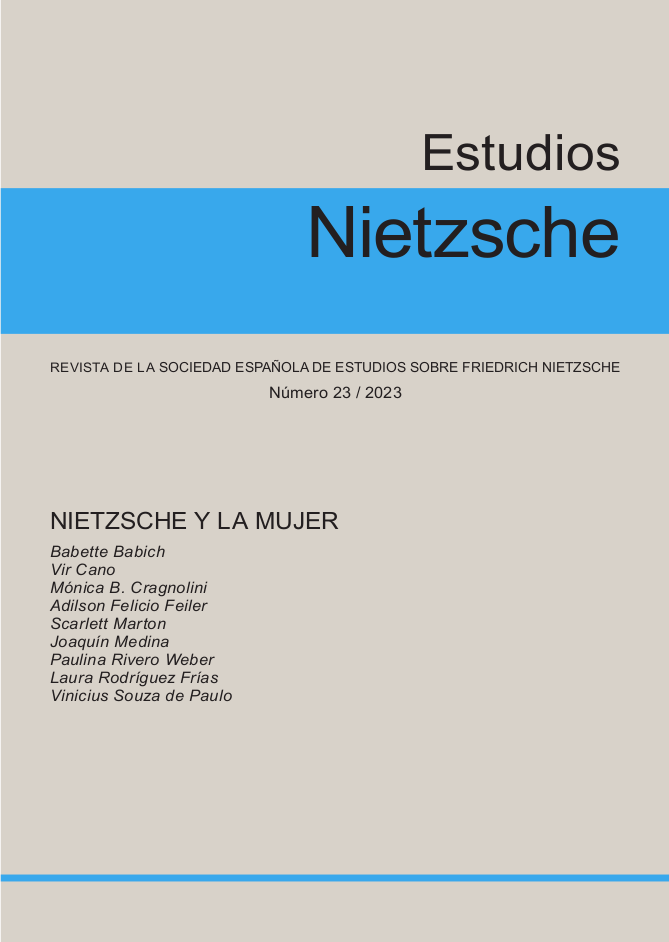The first images of women in Nietzsche's philosophy
the greek woman in the posthumous fragments of youth
DOI:
https://doi.org/10.24310/EstudiosNIETen.vi23.14681Keywords:
woman, feminine, tragic, dionysianAbstract
This article constitutes an analysis of the first references to women in Nietzsche's work, in the writings produced in the so-called first phase of Nietzsche's philosophy, between 1869 and 1876, more specifically, in the posthumous fragments between the years 1869 and 1874, seeking to build a structured interpretation of these posthumous fragments, demonstrating that the theme of women and reflections on the feminine have always had a relevant place in Nietzsche's critique of culture.
Downloads
Metrics
References
BEHLER, Diana. (2010). Nietzsche’s view of woman in classical greece. Nietzsche-Studien, Vol.18, Issue 1, p. 359–376. DOI: https://doi.org/10.1515/9783110244373.359
DAVIES, Peter. (2010). Myth, Matriarchy and Modernity: Johann Jakob Bachofen in German Culture, 1860-1945. Berlin/New York: de Gruyter.
EVANS, Nancy. (2006). Diotima and Demeter as Mystagogues in Plato's Symposium. Hypatia, vol. 21, no. 2, p. 1–27. DOI: https://www.jstor.org/stable/3810989
FOLEY, Helene P. (Eds., 1994). The Homeric hymn to Demeter. Translation, commentary, and interpretive essays. New Jersey: Princeton University Press.
GIACOIA JR., Oswaldo. (2002). Nietzsche e o feminino. Natureza humana, São Paulo, v. 4, n. 1, p. 9-31. DOI: http://pepsic.bvsalud.org/pdf/nh/v4n1/v4n1a01.pdf
KOFMAN, Sarah. (1995). The Psychologist of the Eternal Feminine (Why I Write Such Good Books, 5). Translated by Madeleine Dobie. Yale French Studies, no. 87, p. 173–189. DOI: https://www.jstor.org/stable/2930331
KOFMAN, Sarah. (1998). Baubô: Theological Perversion and Fetishism. Translated by Tracy B. Strong, en OLIVER, Kelly. y PEARSALL, Marilyn. (Eds. 1998). Feminist interpretations of Friedrich Nietzsche. Pennsylvania: Pennsylvania State University Press.
THORGEIRSDOTTIR, Sigridur. (2004). Baubo Laughter Eroticism and Science to come. Nietzscheforschung, v. 19, Issue 1, p. 65–73. DOI: https://doi.org/10.1524/nifo.2012.0004
MACHADO, Roberto. (2017). Nietzsche e a verdade. 3. ed. Rio de Janeiro/São Paulo: Paz e Terra.
NIETZSCHE, Friedrich. (2010). Fragmentos póstumos. Volumen I (1869-1874). 2.ed. Edición dirigida por Diego Sánchez Meca, Traducción, introducción y notas de Luis E. de Santiago Guervós. Madrid: Tecnos.
NIETZSCHE, Friedrich. (2011). Obras completas, Volumen I: Escritos de Juventud. Traducción, introducción y notas de Joan B. Llinares, Diego Sánchez Meca y Luis E. de Santiago Guervós. Madrid: Tecnos.
PAUL JANZ, Curt. (2016). Friedrich Nietzsche: Uma biografia. Vol. 1: Infância, juventude, os anos na Basileia. Tradução de Markus A. Hediger. Petrópolis: Vozes.
SÓFOCLES. (1998). A trilogia tebana. Tradução do grego, introdução e notas de Mário da Gama Kury. 8.ed. Rio de Janeiro: Jorge Zahar.
TACITUS, Cornelius. (1999). Agricola and Germany. Translated with an introduction and notes by Anthony R. Birley. Oxford/New York: Oxford University Press.
VERNANT, Jean-Pierre. (2006). Mito e religião na Grécia Antiga. Tradução de Joana Angélica D’Avila Melo. São Paulo: WMF Martins Fontes.
Downloads
Published
How to Cite
Issue
Section
License
As of issue 21 (2021) this journal is published only in open access (diamond route).
From that number 21, like the previous numbers published in NIETZSCHE STUDIES, they are subject to the Creative Commons Acknowledgment-NoComercia-ShareIgual 4.0 license, the full text of which can be consulted at <http://creativecommons.org/licenses/by-nc-sa/4.0 >
It is the responsibility of the authors to obtain the necessary permissions of the images that are subject to copyright.
This work is licensed under a Creative Commons Attribution-NonCommercial-ShareAlike 4.0 International License.
Copyright generates two different rights: moral rights and patrimonial rights that EJFB recognizes and respects. Moral rights are those relating to the recognition of the authorship. They are rights of a personal nature that are perpetual, inalienable, unseizable and imprescriptible as consequence of the indivisible union of the author and his/her work.
Patrimonial rights are those that can be derived from the reproduction, distribution, adaptation or communication of the work, among others.







11.png)
